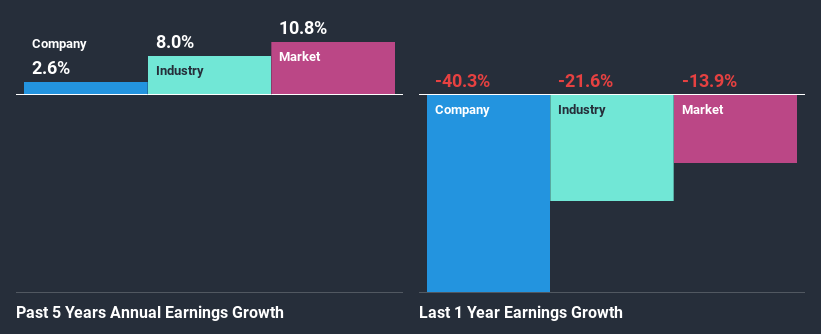- United Kingdom
- /
- Machinery
- /
- LSE:GDWN
Goodwin PLC's (LON:GDWN) Dismal Stock Performance Reflects Weak Fundamentals

Goodwin (LON:GDWN) has had a rough three months with its share price down 16%. We decided to study the company's financials to determine if the downtrend will continue as the long-term performance of a company usually dictates market outcomes. Specifically, we decided to study Goodwin's ROE in this article.
Return on equity or ROE is a key measure used to assess how efficiently a company's management is utilizing the company's capital. Simply put, it is used to assess the profitability of a company in relation to its equity capital.
See our latest analysis for Goodwin
How Is ROE Calculated?
The formula for ROE is:
Return on Equity = Net Profit (from continuing operations) ÷ Shareholders' Equity
So, based on the above formula, the ROE for Goodwin is:
6.6% = UK£7.2m ÷ UK£109m (Based on the trailing twelve months to October 2020).
The 'return' refers to a company's earnings over the last year. So, this means that for every £1 of its shareholder's investments, the company generates a profit of £0.07.
What Has ROE Got To Do With Earnings Growth?
So far, we've learned that ROE is a measure of a company's profitability. We now need to evaluate how much profit the company reinvests or "retains" for future growth which then gives us an idea about the growth potential of the company. Assuming everything else remains unchanged, the higher the ROE and profit retention, the higher the growth rate of a company compared to companies that don't necessarily bear these characteristics.
Goodwin's Earnings Growth And 6.6% ROE
On the face of it, Goodwin's ROE is not much to talk about. We then compared the company's ROE to the broader industry and were disappointed to see that the ROE is lower than the industry average of 8.8%. As a result, Goodwin reported a very low income growth of 2.6% over the past five years.
As a next step, we compared Goodwin's net income growth with the industry and were disappointed to see that the company's growth is lower than the industry average growth of 8.0% in the same period.

Earnings growth is an important metric to consider when valuing a stock. The investor should try to establish if the expected growth or decline in earnings, whichever the case may be, is priced in. By doing so, they will have an idea if the stock is headed into clear blue waters or if swampy waters await. If you're wondering about Goodwin's's valuation, check out this gauge of its price-to-earnings ratio, as compared to its industry.
Is Goodwin Efficiently Re-investing Its Profits?
With a high three-year median payout ratio of 62% (or a retention ratio of 38%), most of Goodwin's profits are being paid to shareholders. This definitely contributes to the low earnings growth seen by the company.
Moreover, Goodwin has been paying dividends for at least ten years or more suggesting that management must have perceived that the shareholders prefer dividends over earnings growth.
Conclusion
Overall, we would be extremely cautious before making any decision on Goodwin. The company has seen a lack of earnings growth as a result of retaining very little profits and whatever little it does retain, is being reinvested at a very low rate of return. In brief, we think the company is risky and investors should think twice before making any final judgement on this company. You can see the 2 risks we have identified for Goodwin by visiting our risks dashboard for free on our platform here.
If you’re looking to trade Goodwin, open an account with the lowest-cost* platform trusted by professionals, Interactive Brokers. Their clients from over 200 countries and territories trade stocks, options, futures, forex, bonds and funds worldwide from a single integrated account. Promoted
New: Manage All Your Stock Portfolios in One Place
We've created the ultimate portfolio companion for stock investors, and it's free.
• Connect an unlimited number of Portfolios and see your total in one currency
• Be alerted to new Warning Signs or Risks via email or mobile
• Track the Fair Value of your stocks
This article by Simply Wall St is general in nature. It does not constitute a recommendation to buy or sell any stock, and does not take account of your objectives, or your financial situation. We aim to bring you long-term focused analysis driven by fundamental data. Note that our analysis may not factor in the latest price-sensitive company announcements or qualitative material. Simply Wall St has no position in any stocks mentioned.
*Interactive Brokers Rated Lowest Cost Broker by StockBrokers.com Annual Online Review 2020
Have feedback on this article? Concerned about the content? Get in touch with us directly. Alternatively, email editorial-team (at) simplywallst.com.
About LSE:GDWN
Goodwin
Provides mechanical and refractory engineering solutions primarily in the United Kingdom, rest of Europe, the United States, the Pacific Basin, and internationally.
Solid track record with excellent balance sheet and pays a dividend.


